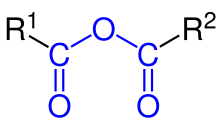Organic acid anhydride

An organic acid anhydride is an acid anhydride that is an organic compound. An acid anhydride is a compound that has two acyl groups bonded to the same oxygen atom.[1] A common type of organic acid anhydride is a carboxylic anhydride, where the parent acid is a carboxylic acid, the formula of the anhydride being (RC(O))2O. Symmetrical acid anhydrides of this type are named by replacing the word acid in the name of the parent carboxylic acid by the word anhydride.[2] Thus, (CH3CO)2O is called acetic anhydride. Mixed (or unsymmetrical) acid anhydrides, such as acetic formic anhydride (see below), are known.
One or both acyl groups of an acid anhydride may also be derived from another type of organic acid, such as sulfonic acid or a phosphonic acid. One of the acyl groups of an acid anhydride can be derived from an inorganic acid such as phosphoric acid. The mixed anhydride 1,3-bisphosphoglycerate is an intermediate in the formation of ATP via glycolysis,[3] is the mixed anhydride between 3-phosphoglyceric acid and phosphoric acid. Acidic oxides are often classified as acid anhydrides.
Preparation
Acid anhydrides are prepared in industry by diverse means. Acetic anhydride is mainly produced by the carbonylation of methyl acetate.[4] Maleic anhydride is produced by the oxidation of benzene or butane. Laboratory routes emphasize the dehydration of the corresponding acids. The conditions vary from acid to acid, but phosphorus pentoxide is a common dehydrating agent:
- 2 CH3COOH + P4O10 → CH3C(O)OC(O)CH3 + "P4O9(OH)2"
Acid chlorides are also effective precursors:[5]
- CH3C(O)Cl + HCO2Na → HCO2COCH3 + NaCl
Mixed anhydrides containing the acetyl group are prepared from ketene:
- RCO2H + H2C=C=O → RCO2C(O)CH3
Reactions
Acid anhydrides are a source of reactive acyl groups, and their reactions and uses resemble those of acyl halides. In reactions with protic substrates, the reactions afford equal amounts of the acylated product and the carboxylic acid:
- RC(O)OC(O)R + HY → RC(O)Y + RCO2H
for HY = HOR (alcohols), HNR'2 (ammonia, primary, secondary amines), aromatic ring (see Friedel-Crafts acylation).
Acid anhydrides tend to be less electrophilic than acyl chlorides, and only one acyl group is transferred per molecule of acid anhydride, which leads to a lower atom efficiency. The low cost, however, of acetic anhydride makes it a common choice for acetylation reactions.
Applications and occurrence of acid anhydrides
- Illustrative acid anhydrides
-
Acetic anhydride is produced on a large scale for many applications.
-
Naphthalenetetracarboxylic dianhydride, a building block for complex organic compounds, is an example of a dianhydride.
-
Maleic anhydride is a cyclic anhydride, widely used to make industrial coatings.
-
ATP in its protonated form is an anhydride derived from phosphoric acid.
-
The "mixed anhydride" 1,3-bisphosphoglycerate (shown in protonated form) occurs widely in metabolic pathways.
-
3'-Phosphoadenosine-5'-phosphosulfate (PAPS) is a mixed anhydride of sulfuric and phosphoric acids and is the most common coenzyme in biological sulfate transfer reactions.
Acetic anhydride is a major industrial chemical widely used for preparing acetate esters, e.g. cellulose acetate. Maleic anhydride is the precursor to various resins by copolymerization with styrene. Maleic anhydride is a dienophile in the Diels-Alder reaction.[6]
Dianhydrides, molecules containing two acid anhydride functions, are used to synthesize polyimides and sometimes polyesters and polyamides. Examples of dianhydrides: pyromellitic dianhydride (PMDA), 3,3’, 4,4’ - oxydiphtalic dianhydride (ODPA), 3,3’, 4,4’-benzophenone tetracarboxylic dianhydride (BTDA), 4,4’-diphtalic (hexafluoroisopropylidene) anhydride (6FDA), benzoquinonetetracarboxylic dianhydride, ethylenetetracarboxylic dianhydride. Polyanhydrides are a class of polymers characterized by anhydride bonds that connect repeat units of the polymer backbone chain.
Natural organic acid anhydrides are rare, because of the reactivity of the functional group. Examples include cantharidin from species of blister beetle, including the Spanish fly, Lytta vesicatoria, and tautomycin, from the bacterium Streptomyces spiroverticillatus.
Sulfur analogues
Sulfur can replace oxygen, either in the carbonyl group or in the bridge. In the former case, the name of the acyl group is enclosed in parentheses to avoid ambiguity in the name,[2] e.g., (thioacetic) anhydride (CH3C(S)OC(S)CH3). When two acyl groups are attached to the same sulfur atom, the resulting compound is called a thioanhydride,[2] e.g., acetic thioanhydride ((CH3C(O))2S).
See also
References
- ^ IUPAC, Compendium of Chemical Terminology, 2nd ed. (the "Gold Book") (1997). Online corrected version: (2006–) "acid anhydrides". doi:10.1351/goldbook.A00072
- ^ a b c Panico, R.; Powell, W. H.; Richer, J. C., eds. (1993). "Recommendation R-5.7.7". A Guide to IUPAC Nomenclature of Organic Compounds. IUPAC/Blackwell Science. pp. 123–25. ISBN 0-632-03488-2.
- ^ Nelson, D. L.; Cox, M. M. "Lehninger, Principles of Biochemistry" 3rd Ed. Worth Publishing: New York, 2000. ISBN 1-57259-153-6.
- ^ Zoeller, J. R.; Agreda, V. H.; Cook, S. L.; Lafferty, N. L.; Polichnowski, S. W.; Pond, D. M. "Eastman Chemical Company Acetic Anhydride Process" Catalysis Today (1992), volume 13, pp.73-91. doi:10.1016/0920-5861(92)80188-S
- ^ Lewis I. Krimen (1988). "Acetic Formic Anhydride". Organic Syntheses; Collected Volumes, vol. 6, p. 8.
- ^ Heimo Held, Alfred Rengstl, Dieter Mayer "Acetic Anhydride and Mixed Fatty Acid Anhydrides" Ullmann's Encyclopedia of Industrial Chemistry 2002, Wiley-VCH, Weinheim. doi:10.1002/14356007.a01_065





